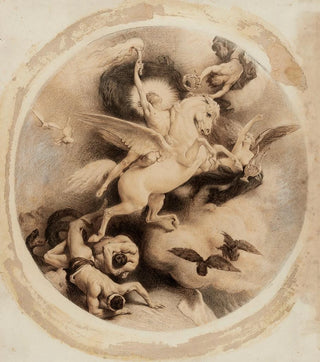Art print | The Triumph of Art - Léon Bonnat


View from behind

Frame (optional)
In the vast panorama of art history, certain works stand out for their ability to capture the very essence of human creativity. "The Triumph of Art" by Léon Bonnat is undoubtedly one of these iconic pieces. It evokes not only the technical mastery of the artist but also a profound reflection on the role of art in society. By contemplating this work, the viewer is transported to a universe where beauty and virtuosity meet to celebrate the transcendent power of art. The art print of this piece allows access to this rich and complex universe, while offering an invitation to explore the message the artist intended to convey.
Style and uniqueness of the work
Bonnat's style is characterized by a realistic approach, tinged with a certain romantic grandeur. "The Triumph of Art" stands out for its dynamic composition, where figures intertwine in a visual choreography that captures the eye and imagination. The colors, carefully chosen, oscillate between warm tones and darker shades, creating a harmonious balance that enhances the emotional impact of the work. Light plays a crucial role in this composition, illuminating the faces and gestures of the characters, as if to emphasize the importance of art in their existence. Every detail is meticulously crafted, reflecting Bonnat's meticulousness and passion for his craft. This work does not merely depict artistic figures; it elevates them to symbols, embodying the struggle and victory of art over life's vicissitudes.
The artist and his influence
Léon Bonnat, a major figure of the 19th century, marked his era with his commitment to an art that combines tradition and modernity. Trained at the École des Beaux-Arts in Paris, he mastered the lessons of the old masters while experimenting with new techniques. His influence extends far beyond his personal production, impacting many contemporary and future artists. Bonnat also played a vital role in promoting young talents, helping shape the artistic landscape of his time. Through "The Triumph

Matte finish

View from behind

Frame (optional)
In the vast panorama of art history, certain works stand out for their ability to capture the very essence of human creativity. "The Triumph of Art" by Léon Bonnat is undoubtedly one of these iconic pieces. It evokes not only the technical mastery of the artist but also a profound reflection on the role of art in society. By contemplating this work, the viewer is transported to a universe where beauty and virtuosity meet to celebrate the transcendent power of art. The art print of this piece allows access to this rich and complex universe, while offering an invitation to explore the message the artist intended to convey.
Style and uniqueness of the work
Bonnat's style is characterized by a realistic approach, tinged with a certain romantic grandeur. "The Triumph of Art" stands out for its dynamic composition, where figures intertwine in a visual choreography that captures the eye and imagination. The colors, carefully chosen, oscillate between warm tones and darker shades, creating a harmonious balance that enhances the emotional impact of the work. Light plays a crucial role in this composition, illuminating the faces and gestures of the characters, as if to emphasize the importance of art in their existence. Every detail is meticulously crafted, reflecting Bonnat's meticulousness and passion for his craft. This work does not merely depict artistic figures; it elevates them to symbols, embodying the struggle and victory of art over life's vicissitudes.
The artist and his influence
Léon Bonnat, a major figure of the 19th century, marked his era with his commitment to an art that combines tradition and modernity. Trained at the École des Beaux-Arts in Paris, he mastered the lessons of the old masters while experimenting with new techniques. His influence extends far beyond his personal production, impacting many contemporary and future artists. Bonnat also played a vital role in promoting young talents, helping shape the artistic landscape of his time. Through "The Triumph






